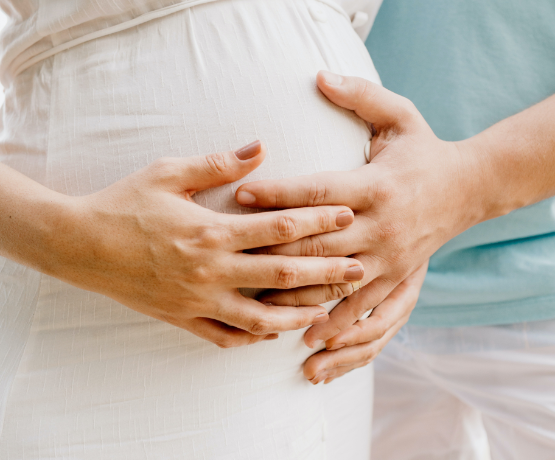Exposing This Stealthy Pregnancy Blocker & How To Fix It
Fibroids are benign muscular tumors arising from the uterine wall, fueled by estrogen dominance and often exacerbated by environmental toxins.
Uterine fibroids are extremely common, affecting 70-80% of women in their lifetimes. But when it comes to fertility troubles, fibroid links often go undiagnosed.
As a functional fertility specialist, fibroids are often an underlying root cause of “unexplained infertility”—one that traditional medicine often overlooks.
The good news is fibroids can often be addressed holistically, preventing serious interventions such as complex surgeries or IVF treatment and opening couples up to a pathway to healthy, natural pregnancy.
Fibroids and Unexplained Infertility
Women experience the effects of fibroids differently. Some uterine fibroids are stealthy, silent saboteurs—for example, small or medium-sized fibroids often cause no symptoms at all. For others, even small fibroids can trigger noticeably bothersome symptoms.
The most common signs of fibroids are:
- Heavy, prolonged menstrual periods – flooding through pads or tampons more frequently
- Menstrual cycle pain – moderate to severe cramps, aches, pressure, or stabbing sensations
- Pelvic pain between periods
- Low backache
- Frequent urination
- Constipation or bloating
- Painful intercourse
Larger fibroids can sometimes cause a visible bulge of the lower belly. Heavy bleeding from fibroids can also lead to anemia, accompanied by fatigue, weakness, pale skin, shortness of breath, and dizziness/lightheadedness, particularly when moving from sitting or lying down to standing.
Though not everyone has symptoms, fibroids can make day-to-day life extremely hard, even aside from struggling to conceive.
There are several ways fibroids sabotage female fertility:
- Anatomical distortion – Fibroids growing inside the hollow uterine cavity can physically block an embryo from implanting properly. But even when located within the muscular uterine wall rather than the inner lining, these benign tumors can still cause trouble by pressing on and squeezing vital nearby reproductive organs. For example, a fibroid outside the endometrium can restrict or kink the thin fallopian tubes through which eggs must smoothly travel to encounter sperm.
- Inflammation – As with any tumor, inflammation increases systemically which adversely affects the ovarian follicles, fertilization, and implantation capability. Inflammation also causes every other system in the body to work harder, redirecting key resources to survival processes rather than reproductive ones.
- Hormonal disruption – Excess estrogen circulating from fibroids overwhelms progesterone in the fertile window. This impairs ovulation, conception, and development of pregnancy, as well as increasing the risk of early miscarriage.
Holistic Medicine for Fibroid Reduction and Restoring Fertility
Functional protocols work synergistically to shrink fibroids through hormonal modulation, reducing inflammation, circulatory support, immune regulation, and detoxification.
Follow these functional medicine principles to naturally reduce the effect of fibroids on your fertility:
- Eat an organic anti-inflammatory whole foods diet centered around vegetables, fruits, legumes, herbs and spices, whole grains, nuts, seeds, and omega-3-rich fish. These kinds of foods lower oxidative stress and excessive estrogen production while promoting liver detoxification. Turmeric, ginger, green tea, cruciferous vegetables, berries, garlic, citrus fruits, nuts, and seeds are particularly helpful for countering pro-fibroid inflammatory pathways and helping resolve nutritional deficiencies that worsen heavy menstrual bleeding.
- Use specific botanical supplements like milk thistle, turmeric, green tea, Ashwagandha, maca, and Dong quai which help modulate estrogen metabolism and support the liver’s detoxification of excess hormones and toxins. This is crucial for fibroid treatment and the prevention of recurrence. Additional anti-inflammatory, hormone-regulating herbs that can provide therapeutic benefits include ginger, burdock root, dandelion, rosemary, ginseng, black cohosh, chamomile, red clover, and chasteberry.
- Consume nutritional supplements like curcumin, omega-3 fatty acids, NAC, vitamin D, B vitamins, iron, magnesium, and zinc, which assist in promoting hormonal balance and healthy circulation which helps prevent heavy bleeding and fibroid growth. Targeted nutraceuticals that support methylation, glutathione production, and detoxification help regulate estrogen metabolism involved in these benign tumors.
- Reduce stress – When we are stressed, the brain tells our body to produce extra hormones intended to help, but which end up over-activating estrogen production, fueling inflammation, and providing the dysfunctional internal conditions that promote rapid fibroid tumor expansion. Practices like journaling, exercise, yoga, deep breathing, and spending time in nature help naturally reduce stress and therefore, bring hormone levels back into balance.
- Get 7-9 hours of restful sleep each night – Overnight, our bodies go into “clean and repair” mode. Skimping on sleep prevents the body from releasing enough melatonin and anti-inflammatory chemicals responsible for that process. Without enough cleaning and repairing time, tissue-damaging inflammation continues to brew which can worsen estrogen dominance, oxidative stress, and impaired immunity – the perfect internal “terrain” to promote rapid fibroid growths.
- Address environmental toxins – Research reveals that exposure to certain environmental toxins like bisphenol-A (BPA), phthalates, some pesticides, and other endocrine disruptors found in our food, personal care items, and surroundings seem to encourage the development and growth of uterine fibroids. These toxic “obesogens” promote metabolic dysfunction, weight gain, higher BMI, and inflammation – all problematic drivers of excess estrogen production.
By lowering daily exposure to such chemicals in our diet and environment, plus supporting proper detoxification pathways, we reduce some of the “extrinsic” factors subtly exacerbating intrinsic hormonal issues perpetuating stubborn fibroid disease. A comprehensive functional medicine approach addresses both sides of this equation – external and internal – for optimal benefit. The key is determining which precise environmental triggers are uniquely problematic for each woman.
As a functional fertility specialist, we have access to the kind of diagnostic tools traditional healthcare providers don’t offer. Once we know what toxins are likely creating fibroid problems and can provide targeted detox protocols and lifestyle changes to pave the road to long-term fibroid resolution and relief.
Conclusion
Fibroids can subtly promote female and couple infertility in various ways: both physically in terms of blockages, but also in terms of creating an inhospitable environment inside the female body. When caught early and skillfully addressed using integrative fibroid reduction protocols, many couples conceive quickly without needing IVF treatment or surgery. As a functional fertility specialist, my passion is identifying and resolving often overlooked root causes like fibroids through holistic medicine tailored to the individual context – delivering miracles once deemed impossible. There is always hope!








